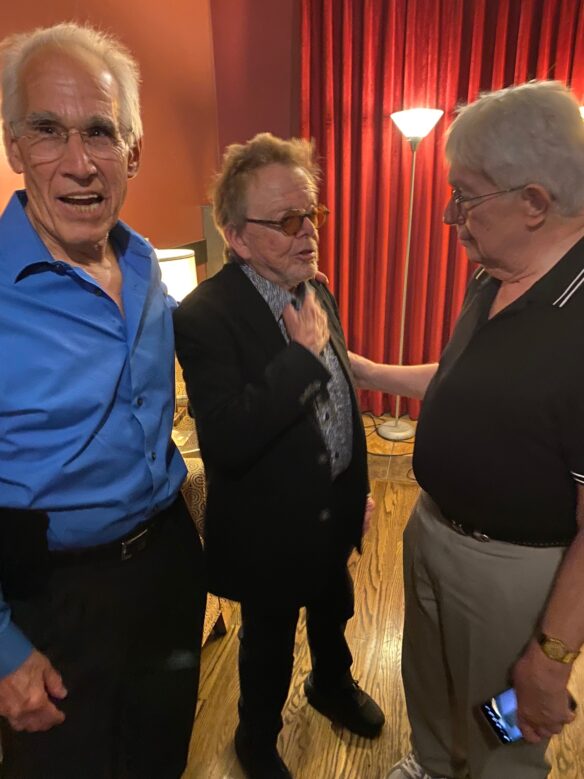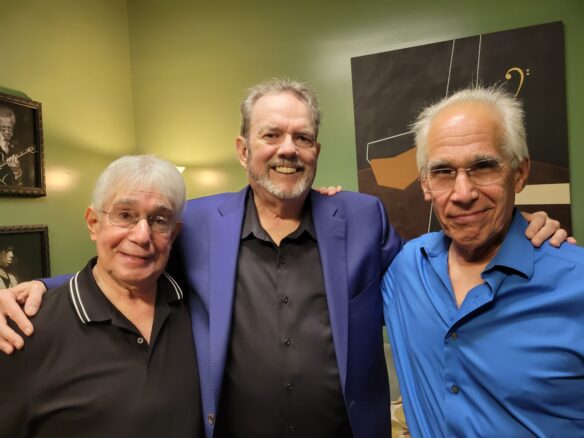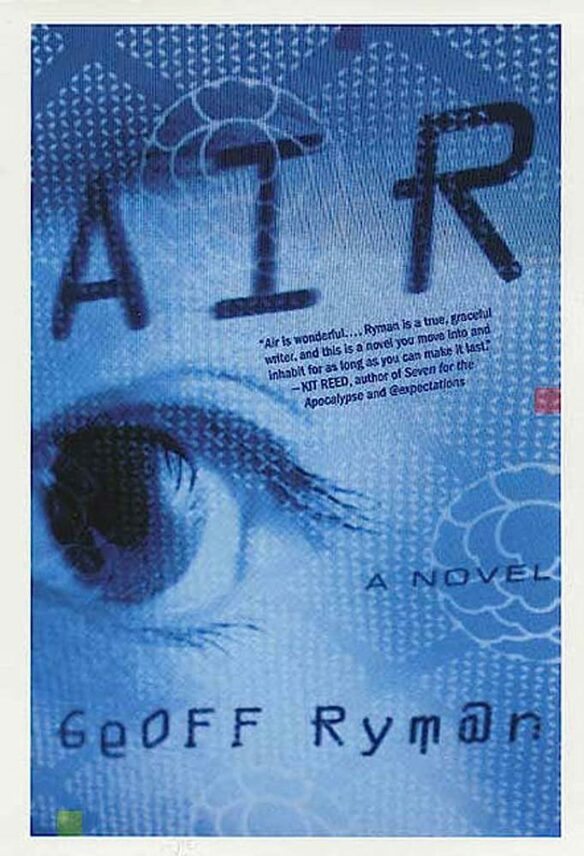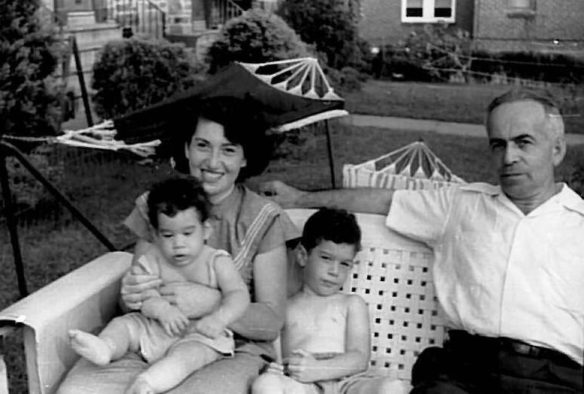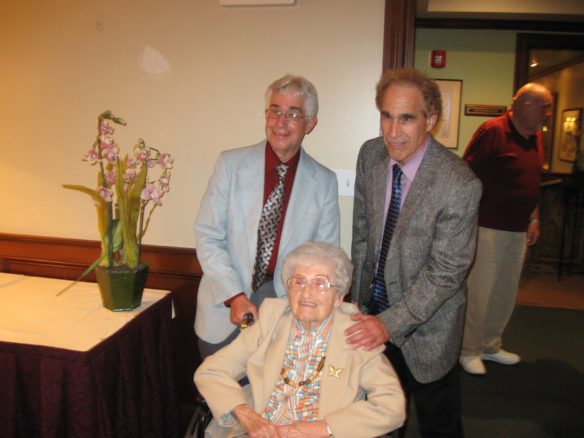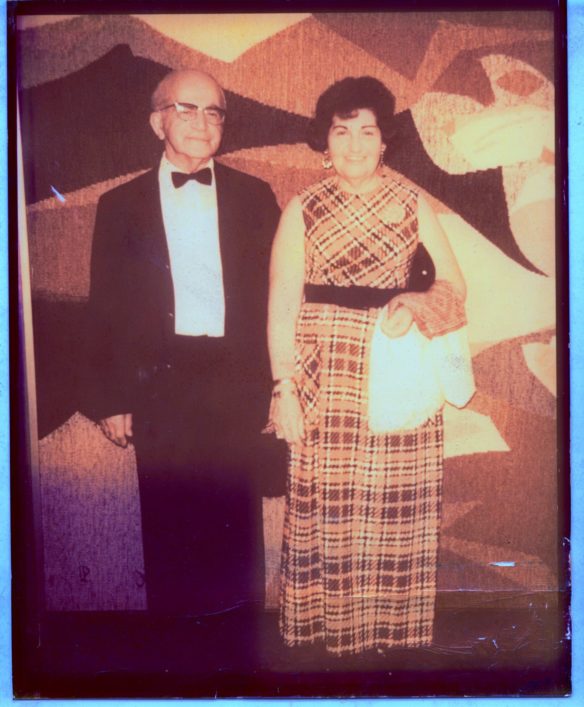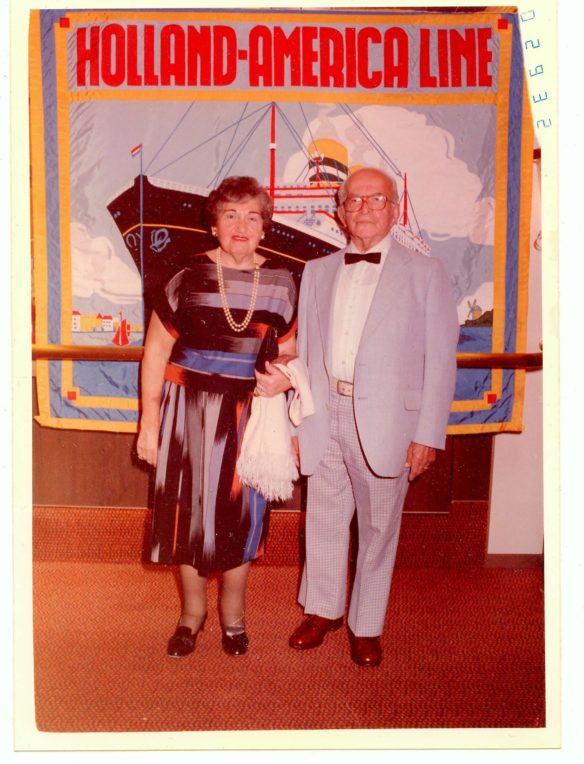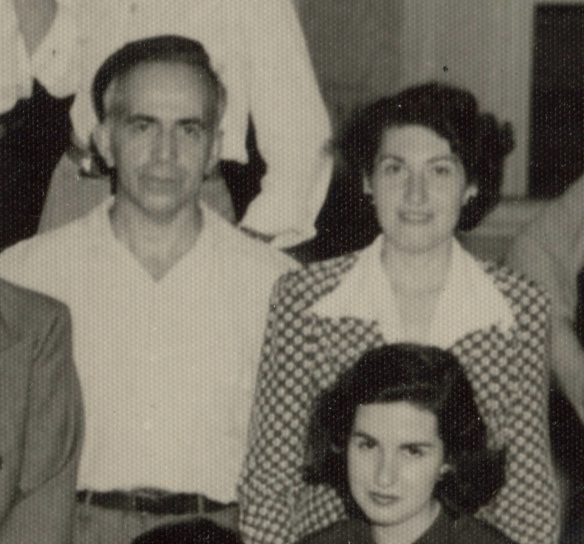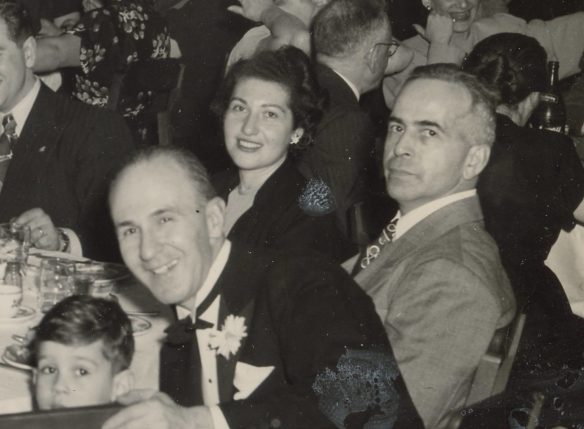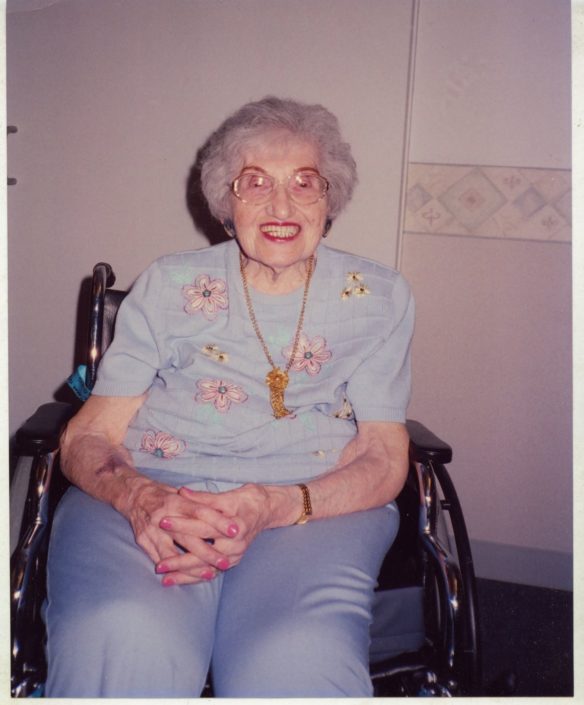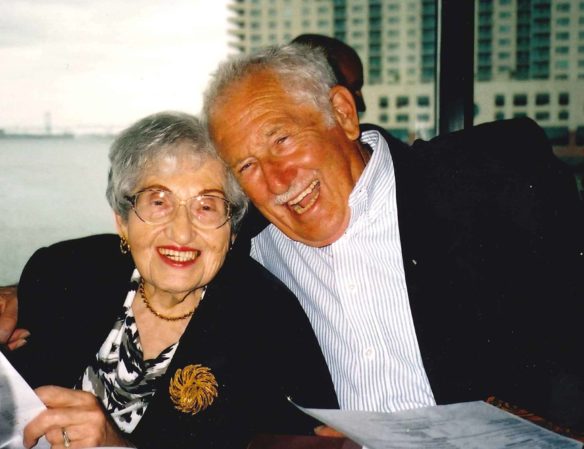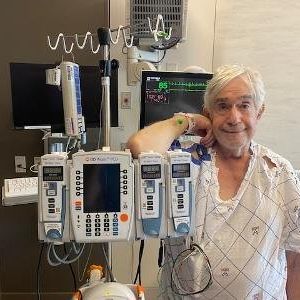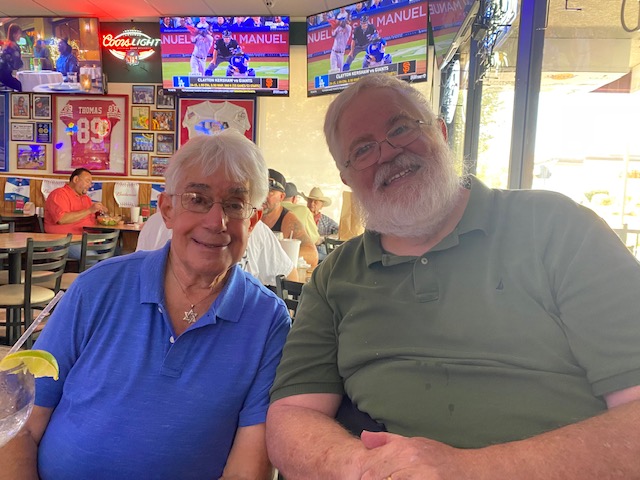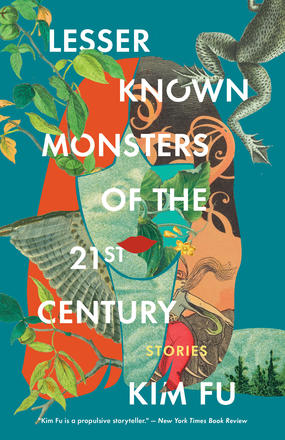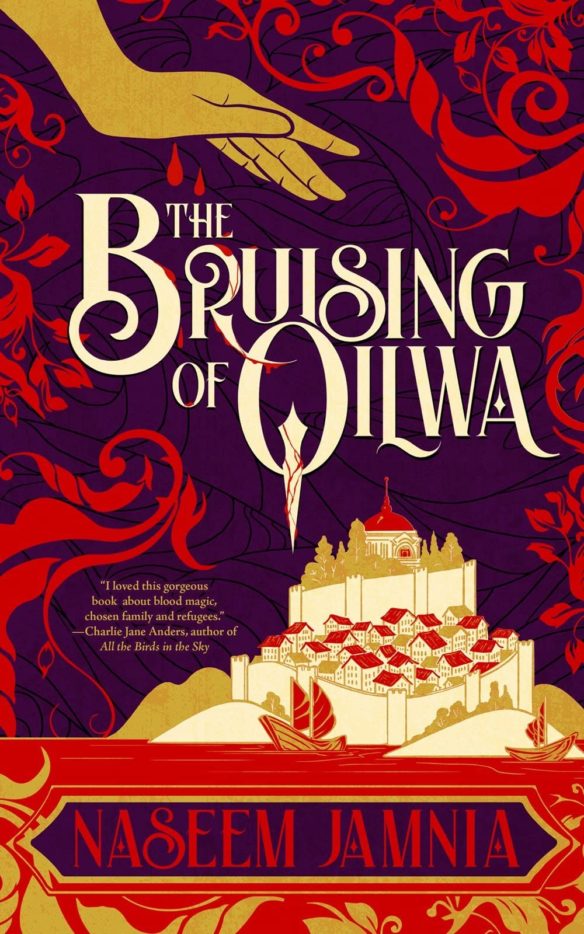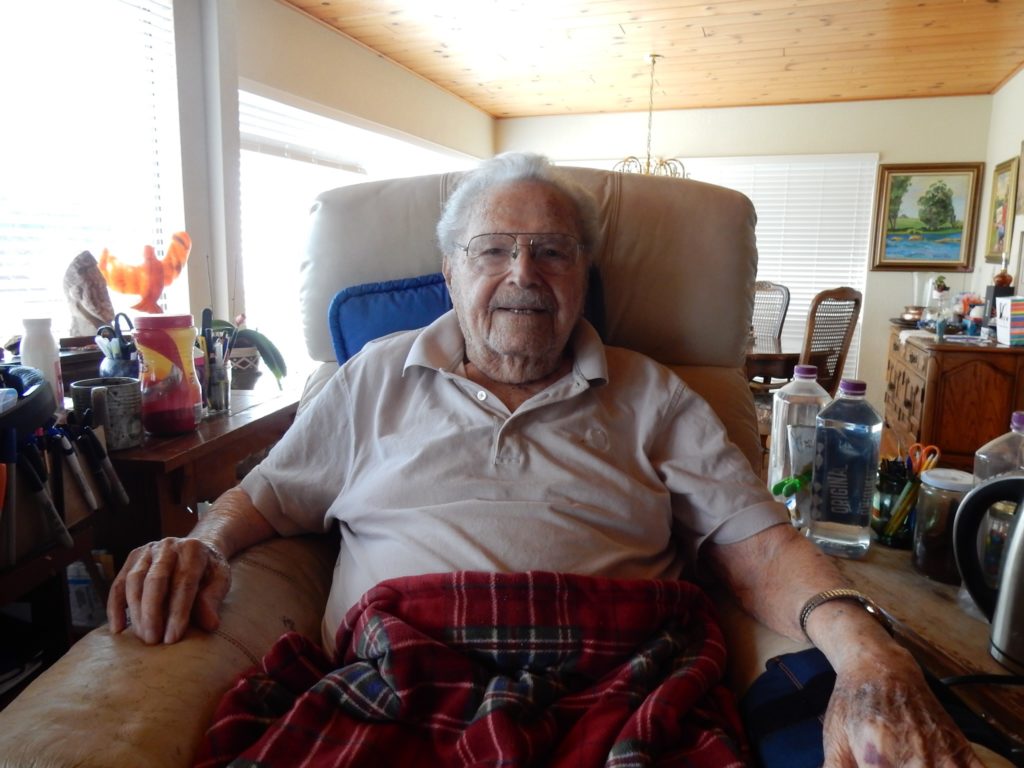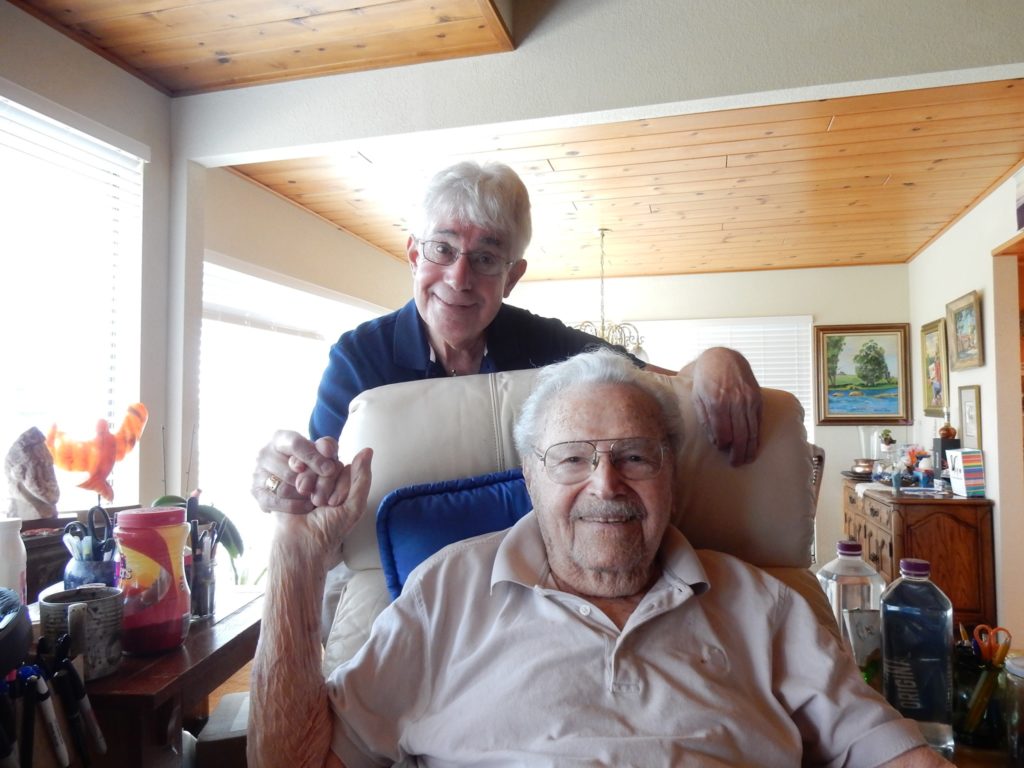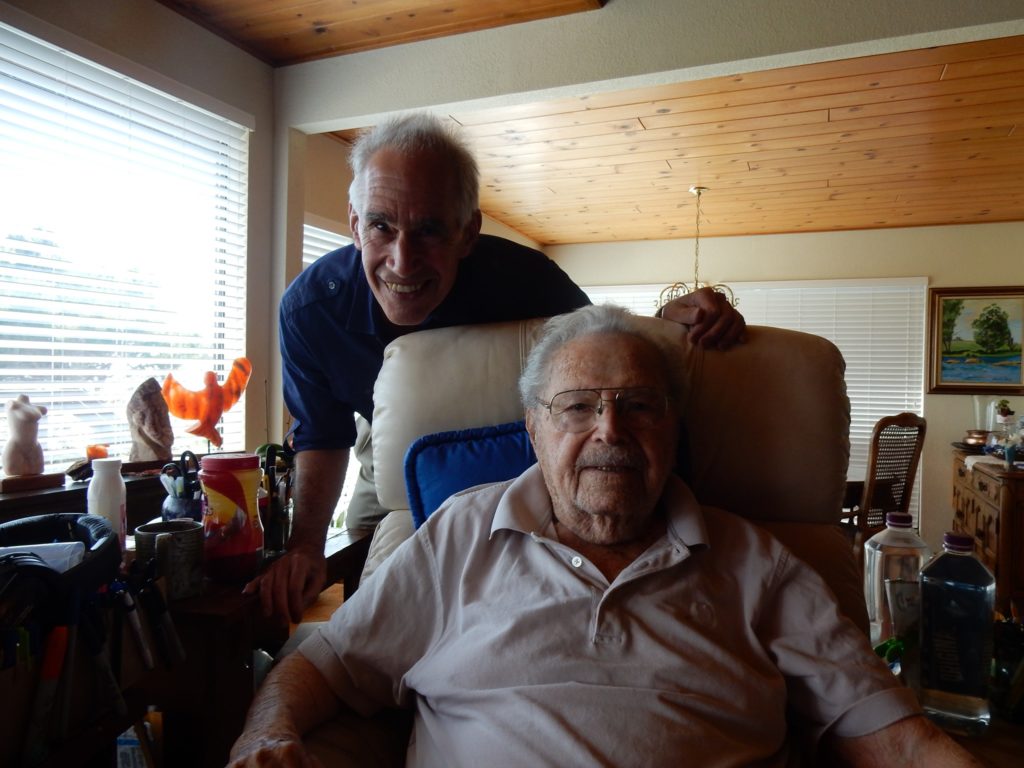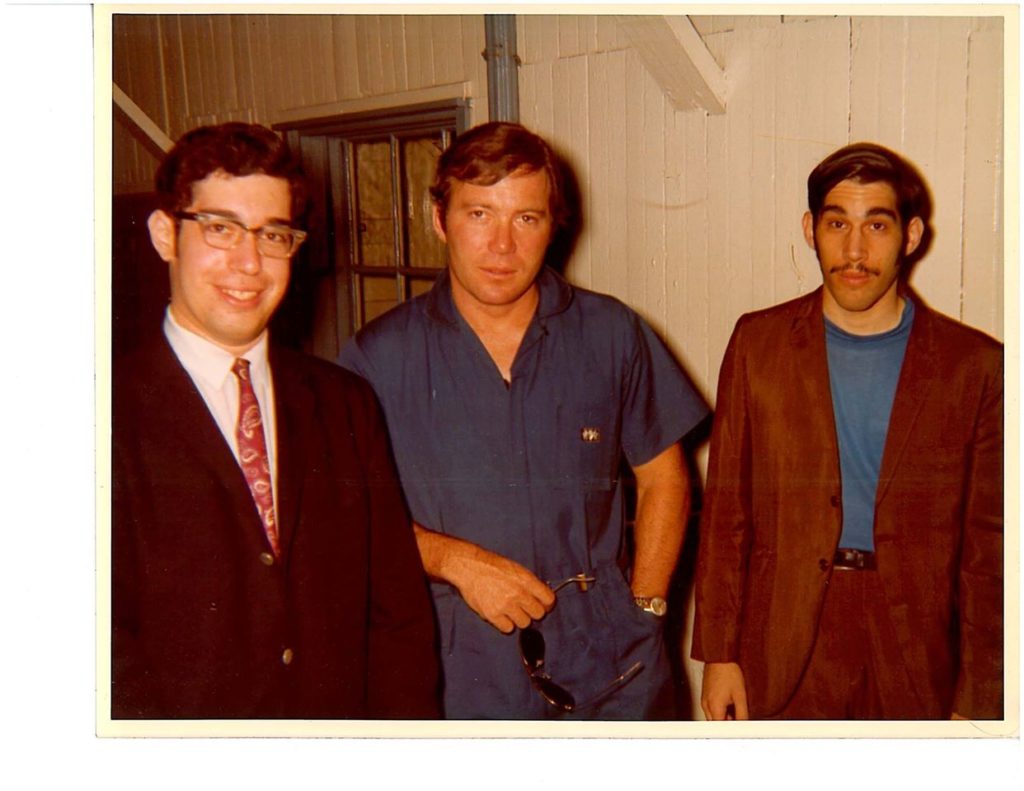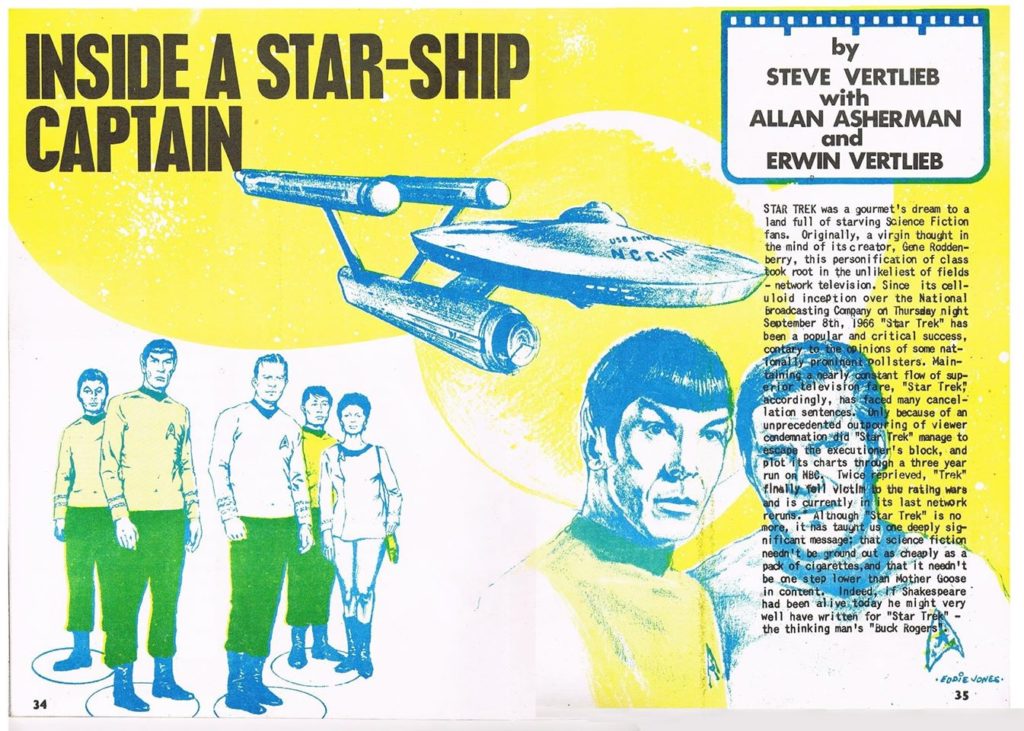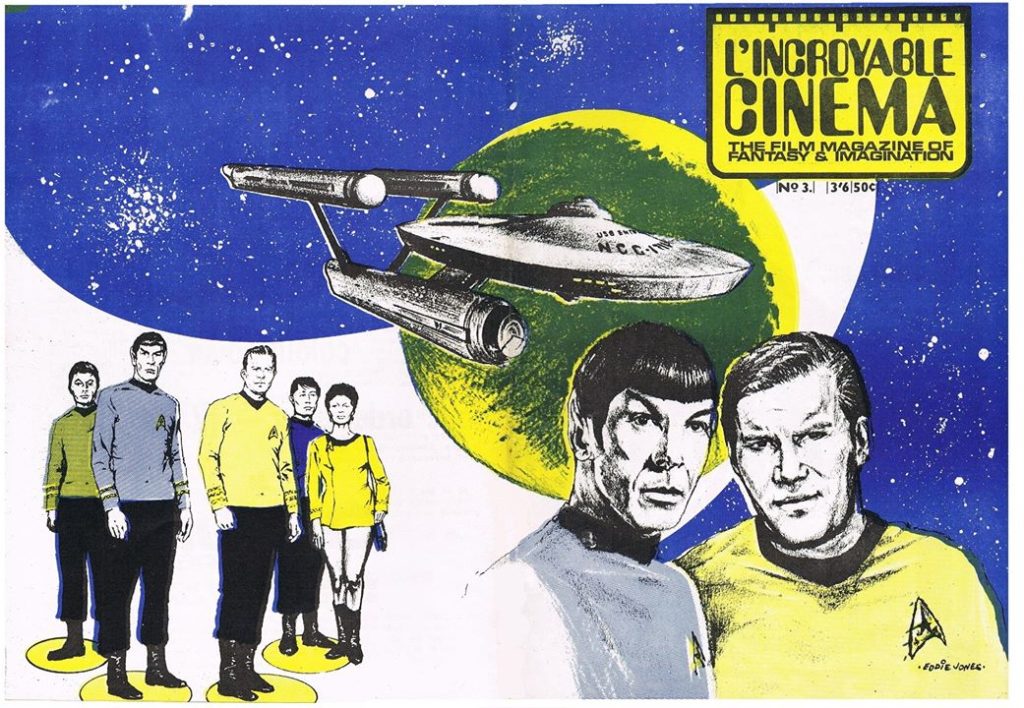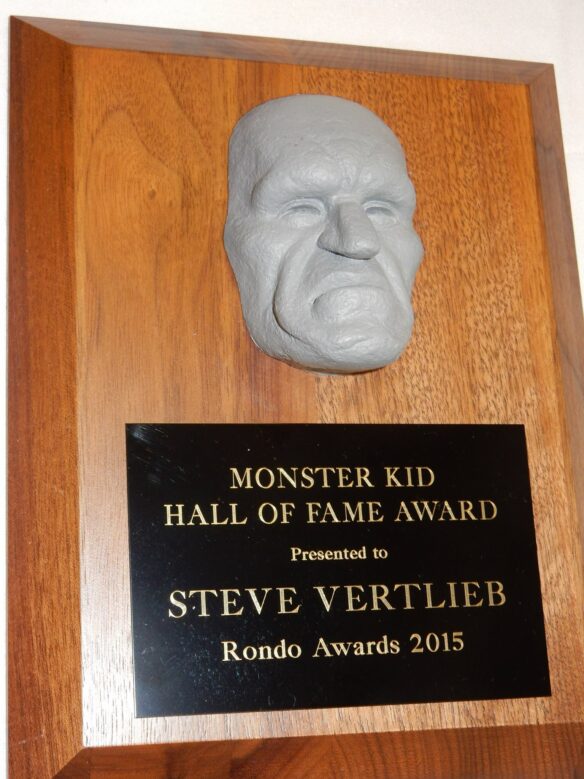

By Steve Vertlieb: When I stop to consider that approximately seventy of my mere seventy-seven years on this planet have been consumed by an overwhelming, passionate, irrational romance with horror in cinema, literature, and art I have to look at myself in the mirror and wonder about the bland, craggy face looking back at me in reflected innocence. My mom and dad might be wondering from beyond just how they might have failed me and, perhaps, how they might have steered me in a somehow inappropriate direction.
For my part, however, I haven’t the slightest doubt. It was in 1950 when my dad brought home our first, small, RCA television. From the moment that this mysterious dark box came to life, with its strangely flickering image, inviting me to become swallowed up within it, I became aware that my young, limited world was about to evolve dramatically.
Suddenly, there was a strange, exciting new world breathlessly transfusing awareness beyond my own limited experience, beckoning me into its murky depths. Murky, of course, because transmissions were broadcast live from primitive studios in grainy, flickering tones of black and white with often muffled sound and imprecise camera angles. However prehistoric these early broadcasts were, I felt like Harry Potter after having waved his magic, sorcerer’s wand in the air for the very first time. A cherished, magic portal had opened in my living room, and I was joyously transported by cathode rays and tubes into a world that I had never conceived or even imagined.
These early excursions into alternate realms of fantasy and adventure introduced me to planets Mongo and Terra, where Flash Gordon and Buzz Corry fought valiantly to save the Earth from mortal danger, and inter-galactic wars waged by Ming, The Merciless and Prince Baccarratti. As portrayed by Larry “Buster” Crabbe and Edward Kemmer respectively, these early heroes and role models (along with William Boyd as Hopalong Cassidy) definitively began to shape the course that my life would take. I was just four years old, but these larger than life heroes would make a connection with my youthful psyche that I cherish to this day.
I was a shy, introverted little boy but, through these heroic excursions into the unknown, in which my own maturity and thoughtfulness would be tested daily, I began to grow into the man that I’ve become. Surely the culture and morality that I inherited from my mom and dad balanced the somewhat more unconventional experiences pervading my hours spent lost in early television, but there cannot be any doubt that my life’s choices over the past fifty years were, to a large extent, formulated by these visions of worlds and galaxies beyond my simple innocence growing up in the 1950’s.
My mother was very protective of me, however, and seldom allowed my little brother Erwin and I to venture far from home and hearth. Indeed, when my little neighborhood friends began to frequent The Benner Theater a mere block-and-a-half from my home for their weekly Saturday Matinee ritual, I was often not permitted to join them.
It was a thrill, sadly experienced vicariously, to listen to their thrilling tales of a demented sculptor living in a horrific House Of Wax, and of rampaging giant ants marauding through the streets of Los Angeles in Them.
In 1957 when Ray Harryhausen’s 20,000,000 Miles To Earth played at The Benner Theater, I could only walk to the back of the theater, press my ear against the door, and listen excitedly to the Venusian roar of the giant Ymir trapped atop the Rome Colosseum. My imagination soared as I tried to visualize the moment projected on screen inside the darkened theater.
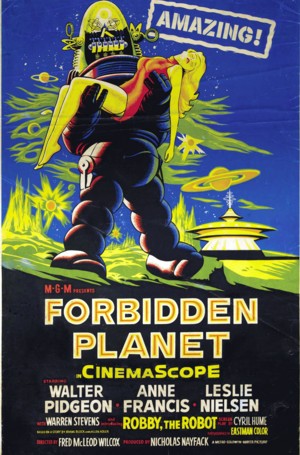
A year earlier, Erwin and I had gone to The Benner to see the opening performance of Forbidden Planet on a sultry Sunday afternoon in 1956. We had been eagerly awaiting the opening of what, up until then, had been proclaimed the most ambitious science fiction movie ever produced. For fully a year before its opening, we’d been drooling over tantalizing drawings on the boxes of Rice Chex and Wheat Chex breakfast cereals announcing its coming.
Now the wondrous day had at last arrived and, as we sat mesmerized in our seats watching the landing of the majestic space cruiser onto Altair 4, an usher tapped me on the shoulder to tell me that we had to leave, and that my mother was waiting for us in the lobby. Properly indignant and outraged, I did what any sensible ten year old boy would do in similar circumstances. I refused to budge.
My mom came down the aisle in short order to tell us that we were all traveling by bus to visit my hated great Aunt Jenny for dinner. “You go without us,” I protested. It didn’t work. No self respecting, responsible parent was about to leave a helpless ten year old, along with his eight year old little brother alone to fend for themselves for the evening. That was the end of our much anticipated viewing of Forbidden Planet on the big screen. I wasn’t to see it again until many years later on a small black and white television screen.
At ten years of age I was now completely under the spell of imagi-movies. However, in my lonely, claustrophobic world, I alone kept that increasingly guilty secret. Other than my brother, who wistfully shared my imaginative dreams and longings, there was no one else alive who felt as we did. And then, in 1957 or 1958, while browsing the magazine rack in our local drug store, Burt’s Pharmacy, my eyes grew wide in excitement as I spied a lonely magazine sitting on the shelf. The publication was called Famous Monsters Of Filmland.
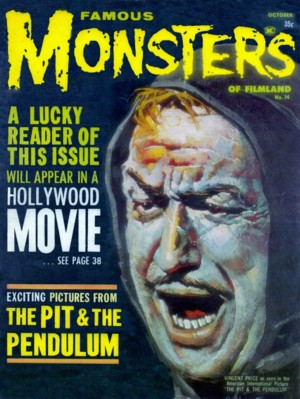
Famous Monsters of Filmland
Could it be true, I wondered? My brain struggled to believe that there actually were other kids out there who might be entranced by movie monsters. My little fingers reached out longingly, and grasped this cherished magazine in my hands. Tenderly, I poured through its pages. My pulse quickened. There in my hands were tributes to Boris Karloff, Bela Lugosi, Lon Chaney, Sr., Lon Chaney, Jr., Vincent Price, Frankenstein’s unholy monster, Dracula, The Wolf Man, and my cherished King Kong.
I walked somewhat unsteadily to the counter, and paid for my copy. I was almost afraid that an adult might grab it from my hands and yell out “You can’t have this. This isn’t for the likes of you.” Racing to my bedroom at home, I poured over every page, every paragraph, every sentence, and every photograph. I was giddy with exultation. I had tears in my eyes as I turned at last to the final page and back cover. I wasn’t alone any longer. I’d found my direction. I’d found my purpose. I’d found my life. I’d come home at last.
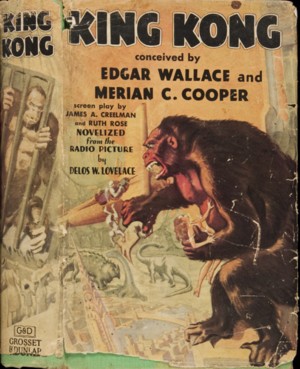
King Kong
King Kong had long since become my favorite film. I’d seen it dozens of times. Then, in 1965, Bantam Books brought out the first paperback edition of the novelization of King Kong by Delos W. Lovelace (based upon the original story by Merian C. Cooper and Edgar Wallace). I bought the book and wondered at once if it might be possible to somehow reach Kong’s creator, Merian C. Cooper.
I’d already met the stars of my of favorite television show, Route 66 (George Maharis and Martin Milner) in 1961 while they were filming an episode of the series in Philadelphia. Then in 1962 I met my first legitimate, if former, movie star, Richard Arlen in a Philadelphia department store. He was hawking a men’s perfume line.
I’d obviously grown drunk with power. I wrote a lengthy fan letter to Merian C. Cooper in care of the New York office of Bantam Books. Both to my shock and delight a few weeks later, a wonderful return letter arrived at my Benner Street home from the creator of King Kong. This would begin an intense, intimate correspondence with General Cooper over the course of the last eight years of his life. It was my first, but it would not be my last, connection with the mighty ape.
Toward the end of 1965 I began to wonder if Cooper might still be in touch with another of my boyhood heroes, Ray Harryhausen. They had, of course, collaborated in 1949 on RKO’s production of Mighty Joe Young.
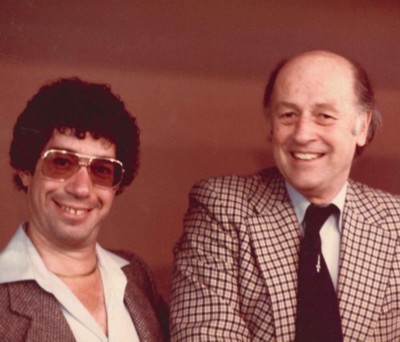
Ray Harryhausen
“Coop” assured me that he was in regular contact with the special effects titan, and offered to introduce us by mail. True to his word, I received an introduction by Kong’s creator to the creator of “Mr. Joseph Young Of Africa,” and my correspondence and friendship with Ray Harryhausen began in earnest in February, 1966.
After that time Ray and I exchanged hundreds of letters, spoke on the telephone, and shared more than a few convention conversations and drinks together. However, the most unforgettable experience of our forty-seven year relationship was when Gary and Sue Svehla announced that Ray would be a featured guest at one of their wonderful Fanex conventions in Baltimore, somewhere around 1990 and, based upon my friendship with Ray, asked if I’d be willing to host a Ray Harryhausen show on stage for his many fans.
Consequently, Ray and I shared the stage for several hours, showing clips from his famous catalogue of fantasy films, and taking questions from the audience. At the end of our program, I helped him carefully restore his original animation models to the case in which he’d transported them, and walked together with him back out into the corridor where his audience awaited with autograph pens in hand. Respectfully, I left him to his adoring admirers. He walked out of the auditorium to the left, while I turned to the right.
Bernard Herrmann
As I exited the large hotel conference room, a man approached me along with, presumably, his wife and little boy.
“Are you the gentleman who was interviewing Ray Harryhausen on stage?” he asked. I replied that I was, indeed, that fortunate fellow.
“You were talking about Bernard Herrmann, and the films that he scored for Ray Harryhausen?,” he asked once more. Once again, I said yes. [Herrmann scored The Three Worlds of Gulliver (1960), Mysterious Island (1961), and Jason and the Argonauts (1963).]
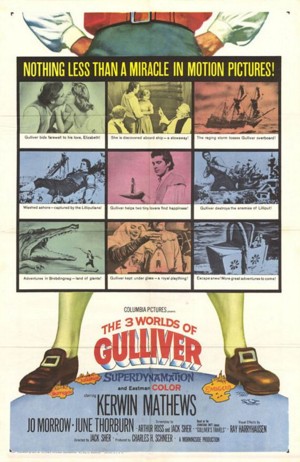
He then turned to his wife and child, and said “I’d like to introduce you to Bernard Herrmann’s daughter and grandson.”
I literally gasped, and clutched my heart. “Oh my God,” I screamed. “Come with me,” I said. “I have to introduce you to Ray.”
I tapped Ray on the shoulder in mid-conversation. He turned back around to face me. Pointing to the woman and small boy, I said “Ray, this is Bernard Herrmann’s daughter, Wendy Harlow, and ‘Benny’s’ grandson.”
Ray, as I had only seconds before, gasped audibly and clutched his heart. His smile widened immeasurably, as he walked over to greet his former collaborator’s family. It was quite an unforgettable moment for both of us.
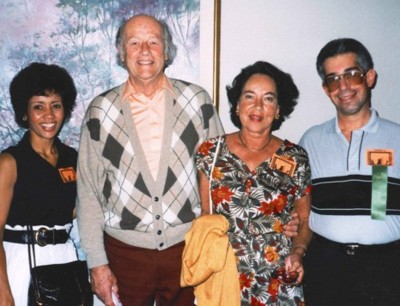
Forry Ackerman
I found myself remarkably adept at letter writing and, in 1964, began a correspondence with the editor of Famous Monsters Of Filmland. During the Summer of 1965 I received a communication from “Forry” Ackerman inviting Erwin and I to New York City to join him for what was billed as the very first “Famous Monsters Of Filmland” convention.
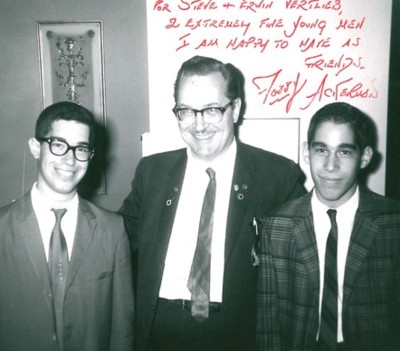
“Monster Con” was to be held at Loew’s Midtown Manhattan Motor Inn on Saturday morning, September 19th, 1965. There, other like minded fans would gather together for the first time ever in celebration of the classic monster films that I’d grown to adore. We took the train early Saturday morning from 30th Street Station in Philadelphia to New York City and there, amidst the daylight terrors of a modern, metropolitan, Transylvanian like city, we met the charming Pied Piper to millions of children around the world.
He was a rather tall, thin, dark haired impersonation of the denizen of Christmas Eve, but I recognized this younger version of Santa Claus instantly from his ingratiating smile, and from the mischievous twinkle in his eye. We took the elevator together from the lobby to the convention suite where we met such star struck teenagers as Gary Svehla, George Stover, Allan Asherman and Walter (Wes) Shank, all of whom continue these nearly fifty years to be both colleagues and friends.
Black Oracle
Somewhere around the late Sixties I began to compose original horror and fantasy poetry for a tiny fanzine called Black Oracle, edited by my friend George Stover.
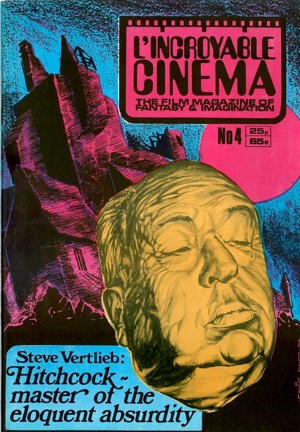
Then in 1969 I received an invitation from a pen pal by the name of Harry Nadler in Manchester, England to write my very first published review for his quite distinguished fanzine, L’Incroyable Cinema.
My first published article was a critique of Stanley Kubrick’s nearly mystical 2001: A Space Odyssey. It wasn’t long before I was writing regular articles, columns, and reviews on either side of the Atlantic for both L’Incroyable Cinema, and Black Oracle.
In the Spring of 1971 my name actually appeared boldly on the cover of issue number 4 of the British magazine, heralding my first of many articles about the life and career of Alfred Hitchcock, “Master Of The Eloquent Absurdity.” That early cover adorns the wall of my apartment living room today.
Arthur C. Clarke
I was attending a film conference in New York City in 1968 during the controversial first screenings of Stanley Kubrick’s 2001: A Space Odyssey when I astonishingly found myself in the men’s room of the host hotel relieving myself next to its celebrated author, Arthur C. Clarke. I hadn’t the nerve to turn my head to address him at that rather inopportune moment.
However, upon returning from the theater later that same evening, on the night following the official New York premiere, I found myself climbing the long, winding staircase as Arthur Clarke was walking down. I approached him and said “Mr. Clarke….I’ve just returned from seeing 2001, and wanted to tell you that I thought it was a masterpiece.”
He chuckled, somewhat bitterly, and remarked that we were the first ones to say that. The critics were mercilessly attacking the new Kubrick film, and no one in those early days of its original release seemed to understand or care for it. In the months that followed, of course, the critics reversed their initially ill-advised criticisms and had begun hailing the film as a monumental achievement.
A year later, at the very same film conference, I bumped into the author again. This time he was surrounded by adoring young fans eager to tell him of their love for his screenplay. When our eyes met, I asked him if he recalled that moment a year earlier when I had said that 2001 was a masterpiece. I reminded him that he had reacted in stunned gratitude, as I had been the only movie goer to say any kind words thus far about the film. Before he had an opportunity to respond, however, some little arrogant twit addressed me sneeringly, and responded “Oh, sure, everyone says that NOW.” In disgrace and utterly humiliated, I skulked away…unable to respond. The account I’ve related is, however, nonetheless true.
Monster Times
It was in 1972 that I went “pro.”
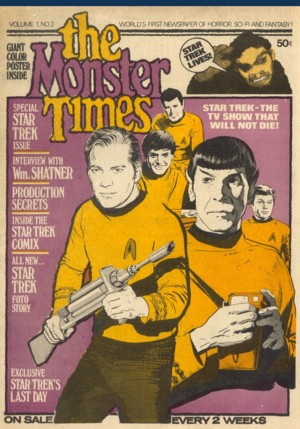
I received a telephone call from an editor by the name of Chuck McNaughton in New York City who was helming what was to become the very first and only bi-weekly tabloid devoted to the classic monster/sci-fi movies of the Fifties and Sixties, The Monster Times. I was to take on the title of Associate Editor, and to pen the opening series of articles for their first issues about the making of King Kong.
My succession of articles debuted in the newspaper under the title of “The Men Who Saved King Kong,” and concerned the making, production, and marketing of the 1933 classic by Merian C. Cooper, Ernest B. Schoedsack, Willis O’Brien and Max Steiner.
I wrote quite a few articles for The Times in those early years. As luck or fate would have it, my work on King Kong was read by a pair of college professors who were busily preparing their own work about the big fellow.
The Girl In The Hairy Paw
Ron Gottesman of Rutgers University, and Harry Gedule at Indiana University wrote, and asked if they might take me out to lunch to discuss a book that they were preparing for Avon Books in New York to be called The Girl In The Hairy Paw. They arrived at my parents’ house, and took me with them to lunch to talk about the very first volume ever devoted to the history and mythology of Merian C. Cooper’s giant creation.
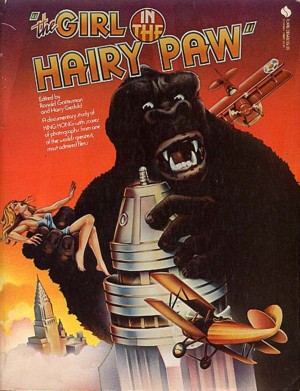
The project was all the more exciting because, despite the fame and enduring popularity of the film, there had never been a book focusing entirely on the topic of King Kong.
After some polite conversation regarding the direction that the volume might take, I agreed to re-write, and formalize my series of articles on Kong for The Monster Times into a more dignified work, befitting a scholarly book being released by a major publisher.
I finished my work, and submitted it to Harry and Ron for their final approval, and my essay became the lead chapter in what many people now consider one of the finest volumes ever published about this battle scarred genre, The Girl In The Hairy Paw.
Published by Avon books in 1976, the volume saw two editions and quickly sold out, quickly becoming a much sought after publication by fans of the film.
My relationship with King Kong continues today, seemingly unabated by time or space. When Warner Brothers Home Video was preparing their premiere DVD restoration of the picture, I was asked to contribute to their lengthy documentary about the production of the film. My name appears in the end titles of the documentary with a “special thanks” credit.
In 1993 I was invited to appear as a guest, along with writer George Turner, at the historic Gateway Theater in Chicago for a sixtieth anniversary celebration of the film. George and I appeared on stage to discuss the making of Kong before a live audience of some seven hundred paying customers and I have, as recently as 2013, completed work on a personal remembrance of my relationship with “Coop” for a forthcoming book about the classic monster film.
A year or so after Cooper’s passing I was able to take my first of many trips to Los Angeles where, thanks to his early intercession, I made a pilgrimage to the Century City apartment of his original leading lady, Fay Wray. We spent an unforgettable couple of hours with this gracious, golden age star, talking about Cooper, Schoedsack, Armstrong and, of course, “the tallest, darkest leading man in Hollywood”…King Kong.
Fanex
The Fanex conventions in Baltimore, sponsored by Gary and Sue Svehla, were growing in both prestige and prominence and, in 2000, they moved their home to Crystal City, Virginia for, perhaps, the most elaborate of their many successful film conventions.
Bernard Herrmann and Alfred Hitchcock
To honor the films and film makers who had inspired them, the Svehlas’ instituted an annual awards celebration honoring the best in genre artistry. Gary wrote me, and said that they would like to present a posthumous life achievement award to legendary composer Bernard Herrmann, and wondered if I might be able to arrange for his daughter Wendy to attend the ceremony to accept the award. He also quite generously asked if I might like to present her with the trophy.
I telephoned Wendy Harlow and asked if she’d be willing to attend. The timing, she explained, was ill-conceived as she was preparing to leave on a trip with her family to Europe.
She suggested that I try to reach her older sister, Dorothy Herrmann in Pennsylvania, and offered me her telephone number. I left a message on Dorothy’s answer machine, explaining who I was and what would be expected of her. Dorothy was a noted author in her own right, having written multiple, definitive biographies of Helen Keller. I received a telephone call from Dorothy later that same afternoon, and I explained that her illustrious father had been chosen, along with Alfred Hitchcock, to receive The Laemmle Award for a career in film. She accepted my invitation, and agreed to accept the trophy on stage with me in Crystal City.
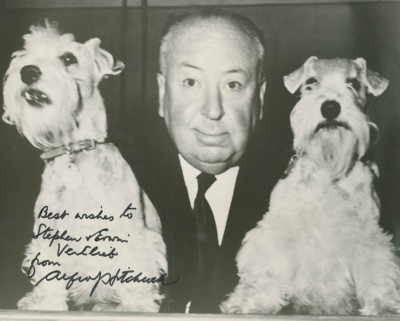
Meanwhile, the announcer who had been scheduled to introduce the guest stars during the opening night festivities had taken ill, and so Gary asked if I might be willing to step in for him. So, here I was…a star struck fan (and former radio/television announcer) sitting behind the booth, announcing over the booming loud speakers to some five hundred paying attendees, introductions for the likes of Janet Leigh, Patricia Hitchcock, Roger Corman, Samuel Z. Arkoff, Margaret O’Brien, Paul Naschy and, of course, Dorothy Herrmann.
On the night of the award ceremony I was sitting next to Pat Hitchcock during a panel discussion of her father’s films. Now, everyone has heard of the infamous feud that broke up the successful screen partnership of Alfred Hitchcock and Bernard Herrmann. I’d even written a lengthy exploration of their relationship for Midnight Marquee Magazine entitled “Hitchcock And Herrmann: The Torn Curtain.”
I didn’t know how these two women would react to one another upon meeting, and I wasn’t anxious to get between them should sparks begin to fly. At the conclusion of our panel discussion, however, a distinguished looking woman approached me and asked if I was Steve Vertlieb.
I said that I was, and she replied “I’m Dorothy Herrmann.” Without a thought for my own, somewhat fragile welfare, I introduced her to Pat Hitchcock who was still seated directly to my right. The two women were very gracious to one another, shook hands, and even managed to chuckle over their respective father’s historic bickering.
I breathed a weary sigh of relief. I was introduced on stage that evening by Veronica Carlson and Yvonne Monlaur. Taking to the podium, I read my admittedly poetic salute to “The Maestro Of The Eloquent Absurdity,” as film clips of Herrmann conducting “The Storm Cloud Cantata” by Sir Arthur Benjamin at Royal Albert Hall, from The Man Who Knew Too Much, illustrated the giant screen behind me. I then introduced Dorothy and her two nephews (Herrmann’s grandsons) who joined me on stage to accept the Laemmle Award. It was a lovely moment.
Miklos Rosza
In a somewhat related vein, I was asked by the management of the famed Castro Theater in San Francisco to put together, program, write liner notes for, and co-host a seventeen film, nine-day festival devoted to motion pictures scored by three time Oscar winning composer, Miklos Rozsa.
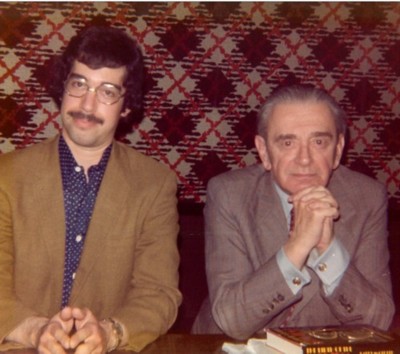
I found myself on stage Saturday night of the festival interviewing the composer’s daughter, Juliet, about her illustrious father’s Hollywood career, and was privileged to read special proclamations and tributes from The Hungarian Ambassador To The United States, The Mayor Of San Francisco, and a very special introduction written especially for the event by Ray Bradbury. Dr. Rozsa had become a cherished friend for some twenty-seven years, and so this festival was, for me, a singular honor.
James Bernard
Continuing in a symphonic vein, Hammer Films’ premiere composer James Bernard became a dear friend over the last seven years of his life, often telephoning me from home in London, while Star Wars composer John Williams has allowed me to join him back stage for the past several years after his sold out annual concerts at The Hollywood Bowl.
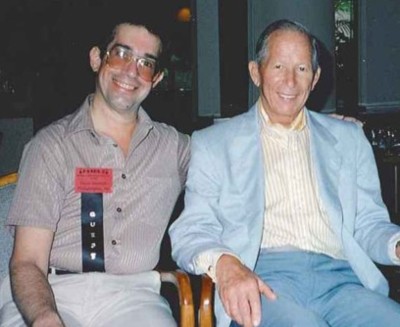
An Hour With Forrest J. Ackerman
Forry Ackerman was no stranger to East Coast conventions, nor was he a stranger at Fanex. At another of these wonderful conferences, Gary and Sue asked if I’d like to host “An Hour With Forrest J Ackerman.” I adored Uncle Forry, and eagerly accepted the invitation. Sharing the stage with this beloved raconteur was a formidable challenge, but I managed to break the ice, both with Forry and the audience, by stooping unashamedly to his level of notoriously bad puns.
I opened the hour by observing that I had been searching for Forry in the hotel lobby, and then out in the parking lot by the woods where “I couldn’t find Forrest for the trees.” He frowned in mock displeasure and rose from his chair as though he were angrily leaving the room. He then sat down once more and responded in kind with one of his own, carefully measured bad puns, to which I groaned in mock anger, rose from my own chair and pretended to begin leaving the room. All in all, it was a very charming interlude.
Robert Bloch
One of my lifelong favorite writers was Robert Bloch, the author of Psycho. I first discovered Bob’s novels and short stories around 1960 when I purchased some of his collections in paperback editions. Nightmares, and More Nightmares were my introductions to his work, and I quickly became an enormous admirer of his skills as an author of horror fiction. I grew ever more impressed with his gifts when Boris Karloff’s Thriller series aired on NBC Television, as many of that memorable program’s most frightening episodes were written by Bloch. I ordered most of his works in paperback form and had them delivered to my parents’ home where I eagerly devoured every delectable word.
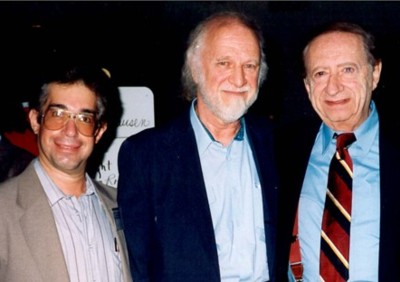
When I learned that he was among the few surviving members of the original H.P. Lovecraft circle of writers, I grew determined to find a way to contact him. It wasn’t long before our paths crossed when, in 1970, I began a furious, twenty five year correspondence with the man who would become my literary mentor. When I first made the trip to Los Angeles on vacation during the Summer of 1974, Robert Bloch became my personal chauffeur.

The literary giant whose historic novel about a boy and his mother inspired Alfred Hitchcock’s masterpiece, Psycho, had volunteered his services as our very own limousine driver, acting as a tour guide throughout the Southern California city. Bob picked us up at my brother’s apartment and spent the remainder of the day pointing out notable tourist sights for this transposed Philadelphia hick. He drove us through the gates of Paramount Pictures where we spent some quality time with George Pal in the producer’s office.
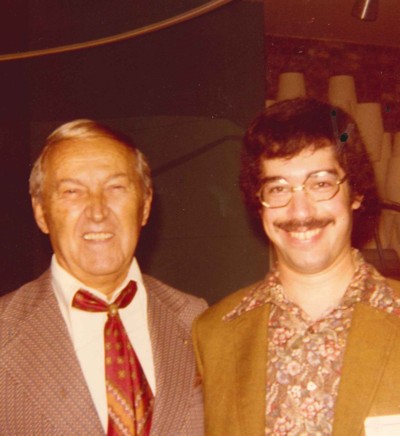
George Pal
George was preparing a mini-series for CBS Television based upon H.G. Wells’ In The Days Of The Comet, and Bob was writing the teleplay. We walked along the famed western street in which John Wayne had fought so many hard won gun fights, and I performed my impression of the Duke’s characteristic stroll…all to the delight of Bob, and to the discomfort of my brother.
As evening graced the Hollywood Hills, we drove to Bob’s home and spent the rest of the evening with Bob and his delightful wife, Elly, over dinner and wine. I noticed some of my magazine articles displayed prominently on the bookshelf in his office. I suspected that he had put them out in honor of my visit, but I smiled, nonetheless. After dinner, Elly prepared a care package for us to take back home. We remained close friends until his untimely death in 1995.

Ray Bradbury
Of my cherished thirty-eight-year friendship with the late Ray Bradbury I will say little, as I’ve written extensively of our relationship elsewhere in a “Rondo”-nominated remembrance (published by Roger Hall’s “Film Music Review” here: www.americanmusicpreservation.com/RayBradburyRemembrance.htm.”). I will simply say that his was a wondrous life, and that I was honored to share his affection for nearly four decades. I shall miss him for as long as my own path continues to carry me to finality.
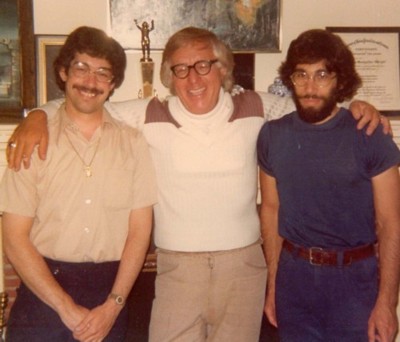
Peter Cushing
Among my many acting heroes was the marvelous Peter Cushing whom I both loved and respected. We began a close personal correspondence that lasted for several years. I remember quite vividly the sincere anguish he so openly expressed to me when his beloved wife Helen passed away. His written candor was nearly too painful to read. I learned that he was coming to New York City to appear as a guest at Forry Ackerman’s Famous Monsters Convention in 1975.
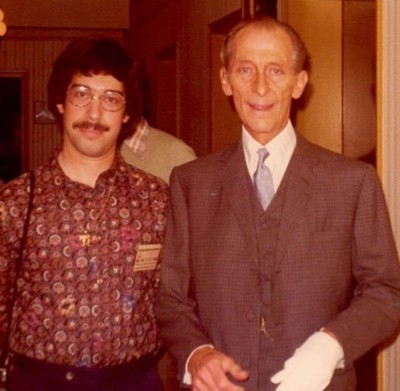
I made certain that I was there to see him in person. As he emerged from the hotel elevator, as charming and dapper as Baron Victor Frankenstein, I approached him. “My Cushing,” I said somewhat timidly, “We used to correspond.”
“What’s your name?” he inquired. “Steve Vertlieb,” I said.
“Oh, yes, I recall. You used to write me with your brother…just like Laurel and Hardy.” Considering that he had appeared with them on screen in their 1939 classic A Chump At Oxford, that was an utterly wonderful moment.
Bramwell Fletcher
I was vacationing in Atlantic City, New Jersey with my parents somewhere around 1964. Erwin and I had been mindlessly strolling along the boardwalk when a small poster in a hotel window caught my attention. An actor was cavorting for the cameras dressed as playwright George Bernard Shaw for a one man show appearing that evening in the hotel theater. What caught my attention, however, was the name of the actor appearing as the famous writer.
It was Bramwell Fletcher, the young actor who had unwittingly unleashed Boris Karloff as “Imhotep” upon humanity in the 1932 Universal production of The Mummy. Fletcher, as the inexperienced young archaeologist, goes mad at the sight of the living corpse, exclaiming in insane laughter “He…He went for a little walk. You should have seen his face.” He is confined to an institution for the hopelessly insane…where he dies, still laughing.
Erwin and I ventured into the lobby of the resort hotel, and I went to the house phone where I asked to be connected with Bramwell Fletcher’s room. I was connected quite quickly, and a rather cultured, unmistakably British voice answered “Hello.”
Rather brazenly, I asked “Is it true that you found the secret of Imhotep?” There was dead silence on the other end of the telephone. Again I asked “Is it true that you discovered the secret of Imhotep?” Once again there was little but confused silence at the other end of the line. He said “I beg your pardon?” My arrogance shattered, I quickly regained my senses and said “Mr. Fletcher, we’re fans of yours from The Mummy, and that was simply a reference to the old Boris Karloff film.” To my relief, there was a hint of warm laughter this time at the other end of the line. I said that we were in the lobby, and wanted to speak with him.
He invited us to come up to his hotel room. We took the elevator up to his floor and knocked on the door to the room number he’d given us. The door opened, and there stood that very same young archaeologist who had opened the sacred Scroll of Thoth so many decades earlier. He was older, of course, and somewhat grayer than we had remembered him but it was Bramwell Fletcher, nonetheless.
He invited us into his room where we had a delightful chat. When I confessed ignorance about his later roles, he reminded us that he had in fact succeeded Rex Harrison as Professor Henry Higgins on the Broadway stage in My Fair Lady. He was kind enough to ask if we’d like to come back that evening and see a performance of the show. We did, of course, and he was delightful. I kept in touch with Bramwell after that by correspondence for several years until his death. He was a most kind and charming gentleman, and I was honored to have known him.
Buster Crabbe
Buster Crabbe was, of course, among my earliest heroes and I was most fortunate to have befriended Buster in his later years when he acted as the official “swim director” for the Concord Hotel in the Catskill Mountains. The title was an honorary one, and served as a great piece of advertising for the hotel in its Summer quest to attract guests. My friend Allan Asherman had recently interviewed Crabbe, and I asked Allan if he might arrange for Erwin and I to visit the Concord and meet Buster.
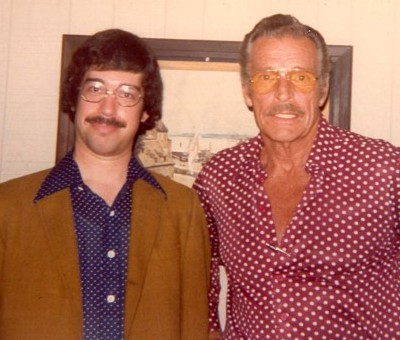
He was kind enough to make the arrangements, and the three of us took the bus from New York City to the hotel on a hot Summer day in 1969. Buster spent an entire afternoon with us, regaling us with his cherished remembrances of Jean Rogers (Dale Arden), Frank Shannon (Doctor Zarkoff), Richard Alexander (Prince Baron), Priscilla Lawson (Princess Aura), and the most villainous adversary in screen history…Charles Middleton (Ming, The Merciless). It was a day of magic, and childhood memories fulfilled. I remained in touch with Buster for many years after that through correspondence. Some ten years after that most enchanting initial get together with Buster, I had returned home to my parents’ house after spending a weekend with friends in Baltimore.
When I stepped into the living room, I asked my dad if anyone had telephoned while I was away. He said “Yes, Buster Crabbe telephoned for you.” I replied “No, really, did anyone call for me?” Again, he said “Yes, Buster Crabbe telephoned the house looking for you.” “Sure he did,” I replied sarcastically.
It took about fifteen minutes for my father to convince me that Buster Crabbe, my original childhood hero, was in town and wanting to get together with me. It seemed that he was in town for a convention appearance at the Holiday Inn, and wanted to have dinner together.
He’d asked everyone at the convention if they knew Steve Vertlieb, and no one did. At least, no one was willing to admit to it. I met Buster the following evening in downtown Philly, and we caught a cab to China Town where we dined in a Chinese Restaurant. What else??? Buster took over duties for my mother that evening and, when he had eaten all that he was going to eat, he emptied the remaining untouched portion of his dinner into my plate and, in typical Jewish mother fashion, urged me to “Eat…Eat.” He was quite a guy, and a genuine hero to me…both on and off the motion picture screen.
I was able to develop a friendship with my other boyhood hero, thanks to Gary Svehla and his trusty Fanex convention.
Ed Kemmer
I learned, to my utter excitement, that Ed Kemmer, Commander Buzz Corry of Space Patrol, was going to appear as a guest at one of the later Svehla film conferences. I had discovered Ed’s home address in the suburbs of New York, and written him a letter. He wrote me back that mine was one of the finest fan letters that he’d ever received. I was thrilled that he had written me, and even more excited that after a lifetime of memories, I was finally going to meet my other hero of my formative years. Ed was most gracious to me. When I told him that I had loved him for fifty years, he grinned and said “You couldn’t possibly be that old.” I assured him that I was, indeed, that old.
We remained in touch for several years, once again through the courtesy of The United States Postal Service. Ed was a huge Sinatra fan and, since Frank Sinatra had been my idol since 1960, I would often make tapes for Ed of rare Sinatra recordings. He wrote me that he had once met Nelson Riddle on the set of The Rosemary Clooney television show which was being directed by his old Space Patrol director. Ed was a wonderful man, and a real life war hero. I was honored to think of him as my friend.
Perhaps the two most enduring and important relationships developed through my involvement with Gary and Sue Svehla, during the Fanex years, were with John Agar and Veronica Carlson.
Veronica Carlson
I first encountered the beautiful Veronica Carlson at a Fanex convention in 1990. Now, I had been deeply in love with Veronica since I first saw her on screen at the Regal Theater in 1968 when I went to see the opening of Dracula Has Risen From The Grave with the wonderful Christopher Lee. When Veronica appeared on camera, however, I thought that my heart would melt.
I thought that she was the most exquisite creature whom I had ever seen. I was hooked from that moment on, and never lost an opportunity to watch the lovely Miss Carlson on screen. It was at that joyous Fanex convention in 1990 that I first met this sweet, gentle creature. I was walking by a gathering of fans in the hotel corridor, and I noticed that Veronica was standing there with them. I turned to look in her direction, too afraid actually to make eye contact, when she simply turned my way as though I had been a part of the conversation from the beginning, and asked what I thought.
I felt as though I had known her forever. She made this complete stranger feel welcome and completely at ease. As a writer and, of course, a poet I asked her if she’d like to read the new poem that I’d written and brought along to the conference. She said that she loved poetry, and would sincerely like to read it. So, I gave her a copy of the poem, and went on my way, never expecting to hear any more of it. The poem, incidentally, was called “Orphan Of The Night,” and concerned a little homeless girl in tattered clothing, seeking comfort and solace from the shadows.
Several hours later, while wandering the hotel hallways, I noticed Veronica walking toward me. As we made eye contact once again, I smiled and said hello. She took my arm in her hands, extended her finger nails and pinched me as hard as she possibly could. Startled, I asked “What was that for?” She replied, rather sweetly I thought, “You made me cry.”

And that, dear reader, was the beginning of a cherished friendship that continues, happily, to this day. When I saw Veronica seated at her “Guest” table at The Monster Bash in Pittsburgh during the Summer of 2011, she asked me to sit next to her as she went along signing autographs for the afternoon. We sat and talked for some four hours and, as she conversed with her many admirers, she asked “And do you know my friend Steve Vertlieb, the famous writer?”
I chuckled and replied “Veronica, I’m only famous to my mother and to you.”
Later we went out to dinner, and had a lovely time…as we have had every time that I’ve seen her over these past twenty-three years. At one particular Fanex convention she asked me quite caringly when I was going to find a girl friend. I looked at her, without the slightest trace of a smile, and said “I’m waiting for you, Veronica.”
There was a moment of awkward silence after that, and then she began to laugh as only Veronica can. What she probably didn’t realize and, perhaps, only partially suspected, was that I wasn’t entirely joking.
It was on the day that Hurricane Sandy hit the Eastern Coast of the United States that I returned home from work to find a message awaiting my response on my answer machine. As I listened, I heard the voice of a beautiful woman with a delightful British accent, inquiring as to my safety and concerned about whether I had weathered the storm. She left no name or telephone number, but I thought that it must have been Veronica.
I called her back on her cell phone, and simply said “You never identified yourself.” She began to laugh in that unmistakable, mischievous laugh that I had come to love, and said that in all of the craziness of the moment, and in her concern for my welfare, that she had forgotten to leave her name. We chuckled and talked for some twenty minutes after that. I cherished our relationship, for she was a beautiful soul, both within and without. I was heartbroken by the tragic news of her passing, and miss her wonderful presence in my life. She was, and always shall be, my treasured friend.
John Agar
Oddly enough, the circumstances under which I first encountered John Agar were strikingly similar to those of my first meeting with Veronica. I was strolling through the corridors at a Fanex convention somewhere around 1982 when I noticed John Agar standing amidst a sea of fans.
I hadn’t planned on speaking to him, as we really hadn’t met but, as had happened with Veronica, John turned to me and began speaking as though we were old friends catching up on each other’s news. I found him to be very warm and generous and we became instant friends. I would run into John many times over the ensuing two decades, and he always greeted me as would a dear friend one hadn’t seen in a while. I would often telephone John and his lovely wife Loretta at their home to wish them a happy holiday, or to see how they were doing. John liked to call me “Stever” whenever we spoke. When Loretta called excitedly to John to pick up the telephone because I was on the line, he always answered with his warmly characteristic, gentle voice “Hiya, Stever.”


I remember once when Shirley Temple had published her book, and John had just been given a copy. John was, of course, Shirley’s first husband. We were together at a Fanex conference and John had just completed reading the chapter about their marriage.
In her book, Shirley had accused John of being drunk in a bar when their daughter was born, rather than being there for her and their child at the hospital. I had never seen John so emotionally enraged before or since. He was shaking in disbelief, tears filling his eyes. He said to me “That’s a damnable lie. It simply isn’t true. I was there at the hospital with the two of them. How could she say a terrible thing like that?”
He openly admitted that he had once battled a drinking problem, but that that he had been free of alcohol for many years. I caressed his back and shoulder, and told him that it was all right, that no one who truly knew him would ever believe such a terrible story. He was badly shaken and wounded, however, and there was little that I could do to console him.
Time eventually caught up with John. Sadly, Loretta passed away and he was left alone. His health was failing, and he had to sell his house. He moved into an apartment as I recall, but his stay there was only brief. Finally, his age and the years of cigarette smoking had done its damage. John had developed a severe case of emphysema, and had to be transported to a nursing home where he might be given proper care and treatment for his fragile lungs.
I was visiting the Los Angeles area at about the time that he was moving into the nursing home. I telephoned him there and asked if I might come by and visit him. He seemed excited about my visit, and so I arranged for a day and a time to stop by. I arrived at the scheduled time with my brother Erwin, and my dear friend Bruce Gearhart. When I peered around the corner and into his room, my heart sank. He was hooked up to oxygen tubes, and sitting in a wheel chair. When he saw me, however, he broke into his trademark smile and he was magically young once more. “Hey, Stever,” he said. “Come on in.”
We stayed with Johnny for about an hour. His strength was not what it was, and he had only limited physical endurance for guests and conversation. His room was sparsely populated with only essential furniture and less than a hand full of pictures. There was a drawing of “Duke” Wayne on the wall and, when I noticed it, he remarked that “Duke was like a father to me.” There was also a small photograph of John with Loretta and the kids taken somewhere in the early 1950’s. A cigarette was dangling carelessly from his fingers. He looked at the photograph, and shook his head sadly. “If I had only known then what I know now about smoking,” he said. John was growing visibly tired. Not wanting to exhaust him, we prepared to leave. I hugged him and gave him a kiss. I told him that I loved him, and that we would speak again soon.
I’d made a few efforts to telephone John in the weeks that followed, but he had grown difficult to reach due to his illness. I must have left a message on his answer machine at the nursing home either on Friday, April 5th or Saturday, April 6th. On Sunday afternoon April 7th, 2002, my telephone rang at around three.
I answered, and a male voice said “Steve, this is Martin Agar.” He didn’t have to say anything else. I knew. My friend John Agar had peacefully passed away. He was one of the finest human beings that it has ever been my privilege to know.
Sometimes, in despair, when I question the direction and meaning of my sixty seven years on this planet, I pause for just a moment and remember the wonderful people and experiences that I’ve known. I think then of a line from a film that has always carried great significance for me. It was the final line from the classic Bette Davis film, Now Voyager. As Davis and Paul Henried are reunited, after having been lost to one another, she looks gratefully ahead to the future, while he regrets the loss of the past. She looks into his eyes, and says “Don’t let’s ask for the moon…We have the stars.”
That brings me comfort for, in truth, I suppose that I do.
++ Steve Vertlieb, June 2024. (An earlier version appeared in 2013.)





